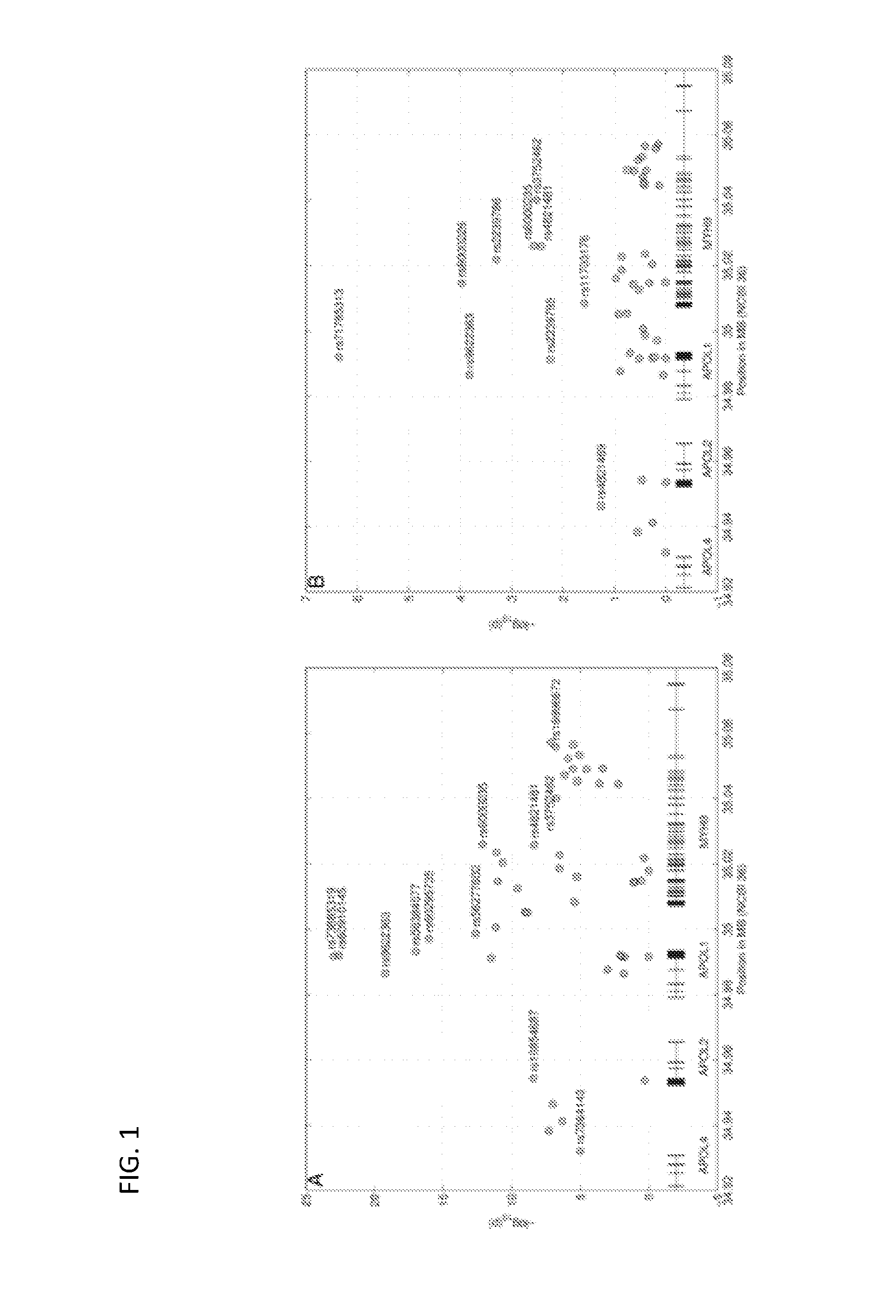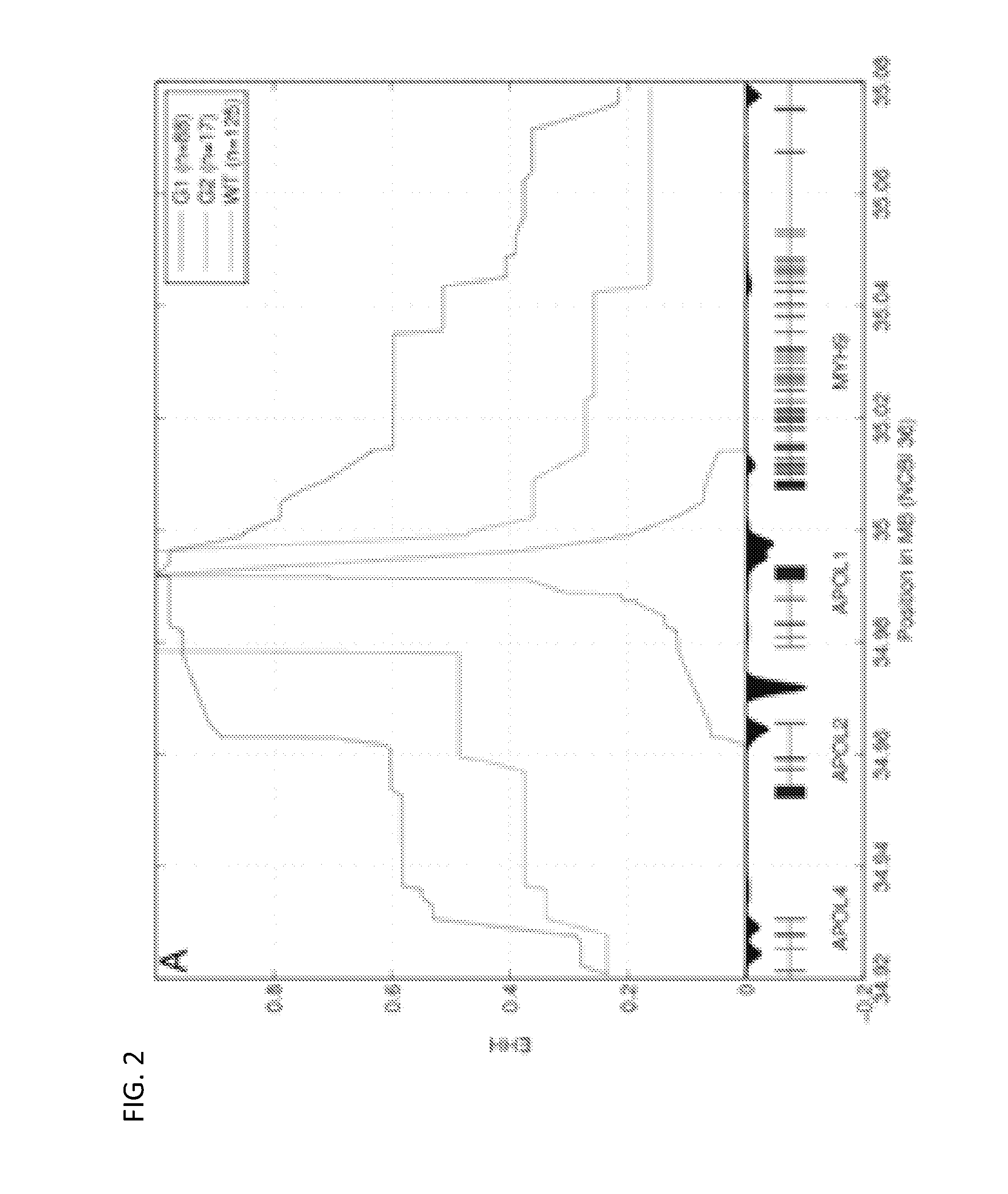Methods of predicting predisposition to or risk of kidney disease
a technology of kidney disease and risk, applied in the field of individualized medicine, can solve the problems of increased risk of kidney damage, increased risk of alleles being susceptible to renal damage,
- Summary
- Abstract
- Description
- Claims
- Application Information
AI Technical Summary
Benefits of technology
Problems solved by technology
Method used
Image
Examples
example 1
APOL1 Variants Associated with Focal Segmental Glomerulosclerosis
Methods
[0294]FSGS Genotype Experiment:
[0295]Variants for the initial FSGS genotype study were selected by accessing 1000 Genomes Project (1000genomes.org / ) data using the Integrative Genomics Viewer (broadinstitute.org / igv). All variants in the region 34,930 kb-35,060 kb (NCBI 36) with estimated minor allele frequency greater than 15% in Yoruba and minor allele frequency less than 10% in Europeans were selected, together with some additional ones with biological relevance, and sent for genotyping using Sequenom technology (sequenom.com). A small amount of SNPs were dropped due to Multiple eXTEND hits for scanned primer triplets and some failed genotyping (Am. J. Hum. Genet. 81:559-575, 2007) using Fisher's exact test and logistic regression.
[0296]Bounds on Causal Variant(s):
[0297]Due to the high frequency differentiation between frequency of alleles G1 and G2 in cases and controls, some formal arguments can be made to ...
example 2
Replication in Hypertension-Attributed EKSD
Methods
[0304]Selection criteria for controls and hypertension-attributed ESKD cases are described in detail in Freedman et al. (Kidney Int. 75:736, 2009). Briefly, self-reported African-Americans from North Carolina, South Carolina, Georgia, Virginia, or Tennessee were recruited. Hypertension-attributed ESKD cases were diagnosed with hypertension prior to initiation of renal replacement therapy, and demonstrated hypertensive target end-organ damage (retinopathy or left ventricular hypertrophy) and low grade or absence of proteinuria. Only a minority of cases had quantified urinary protein excretion. Patients with diabetic (type 1 and 2) ESKD were excluded, as were known cases of cystic kidney disease, hereditary nephritis, and urologic causes of ESKD.
[0305]Geographically similar controls all denied a history of kidney disease and diabetes, or first-degree relatives with these diseases. Most controls did not have direct measurements of arter...
example 3
Evidence of Natural Selection
Methods
[0308]Test for Genetic Divergence in African Populations:
[0309]To test for statistically significant differentiation of allele frequency in between two populations we assume that the difference in frequencies for a given polymorphism has mean 0 and variance cp(1−p), where p is the ancestral frequency and c=2×FST (Ayodo et al., Am. J. Hum. Genet. 81:234-242. 2007). Given the small size of the samples in the two populations analyzed, it is also important to model sampling noise, which has variance p(1−p)(1 / N1+N2), where N1 and N2 are the total count for the alleles for the two populations. Therefore, to test for differentiation of frequency at a given allele, we model the difference as a normal random variable with mean 0 and variance p(1−p)(c+1 / N1+1 / N2) and we compute for each allele a χ2 statistic with 1 df.
[0310]Estimation of the Age of the Selected Allele:
[0311]Because of the presence of a recombination hotspot in between APOL1 and MYH9 (Frazer ...
PUM
| Property | Measurement | Unit |
|---|---|---|
| diastolic blood pressure | aaaaa | aaaaa |
| diastolic blood pressure | aaaaa | aaaaa |
| blood pressure | aaaaa | aaaaa |
Abstract
Description
Claims
Application Information
 Login to View More
Login to View More - R&D
- Intellectual Property
- Life Sciences
- Materials
- Tech Scout
- Unparalleled Data Quality
- Higher Quality Content
- 60% Fewer Hallucinations
Browse by: Latest US Patents, China's latest patents, Technical Efficacy Thesaurus, Application Domain, Technology Topic, Popular Technical Reports.
© 2025 PatSnap. All rights reserved.Legal|Privacy policy|Modern Slavery Act Transparency Statement|Sitemap|About US| Contact US: help@patsnap.com



